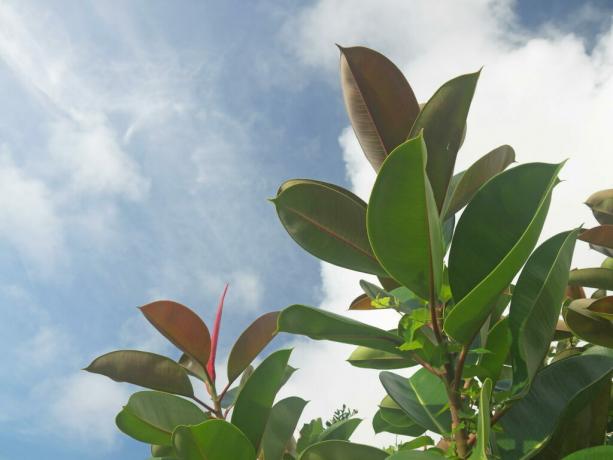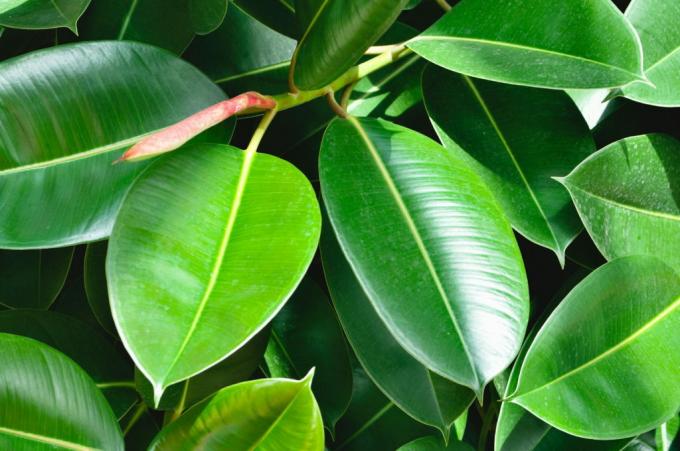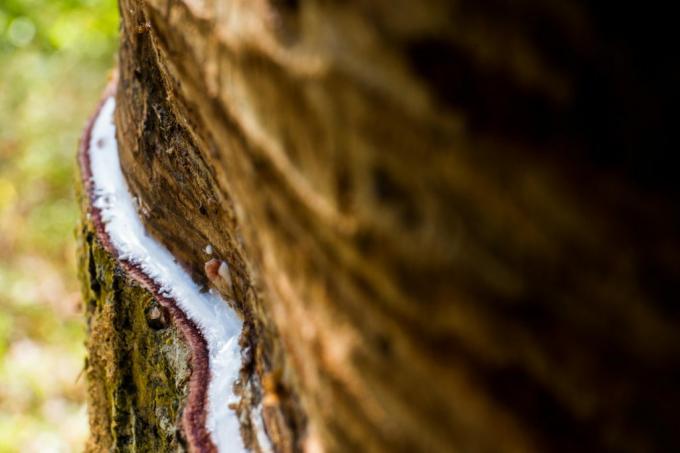In order for the rubber tree to maintain a beautiful growth shape, it must be pruned regularly. Here we show how to properly cut the rubber tree.

Does he feel Rubber tree (Ficus elastica) really comfortable in his home, he can grow up to 60 centimeters in a year. Fortunately, the popular houseplant is extremely compatible with pruning and doesn’t mind a back cut or shaped cut. In addition, regular pruning is necessary to keep the tree in shape and not let it grow too big. In the following, we'll tell you why you should cut your rubber tree, when it is time to cut, and how to do it correctly.
contents
-
Cut rubber tree
- Cutting rubber trees: the right time
-
Cutting rubber tree: instructions
- Cutting rubber trees: curbing growth
- Cutting rubber trees: promoting growth
- Cutting rubber tree: topiary cut
- Cut rubber trees in the event of disease or pest infestation
- Cut rubber tree for propagation
- Maintain rubber tree after cutting
Cut rubber tree
In its home, the tropical rainforests, the rubber tree can grow up to 40 meters in height. Its trunk reaches a diameter of up to two meters. Of course, you cannot and cannot accommodate such a giant in your room. For this reason alone, a regular step on your rubber tree is necessary. But of course there are other reasons to attach the secateurs to the houseplant.
Reasons To Cut Your Rubber Tree:
- Curb growth
- Encourage new growth
- Topiary
- In the event of disease or pest infestation
- To increase
Cutting rubber trees: the right time
In general, you can prune your rubber tree at any time of the year. However, winter is the best time to cut. Then the flow of sap from the tree is lowest. Even in the evening, the milky juice flows less from the cut than during the day, which you can take advantage of when choosing when to cut. If you want to multiply your rubber tree, the best time is to To cut cuttings, in the spring.
Summary of the right time to cut the rubber tree:
- The best time: in winter
- The flow of sap is lowest in the evening
- Cut cuttings for propagation in spring

Cutting rubber tree: instructions
The good news first: rubber trees are very easy on pruning and forgive you a more radical pruning. Always use clean tools for cutting. Either a sharp knife or secateurs are suitable here. Depending on why you want to prune your rubber tree, you have to proceed differently.
Cutting rubber trees: curbing growth
If your rubber tree already reaches the ceiling and is already growing over your head in the truest sense of the word, it is high time to act. To curb the growth, you can boldly cut off the entire crown of the tree. The houseplant is simply shortened to the desired height with the secateurs.
Cutting rubber trees: promoting growth
If you want to encourage your tree to branch, you can easily do that with one cut. Because a cut in the right place stimulates the tree to form new side shoots. First take a good look at your rubber tree and decide where you want new side shoots. Then look for so-called "sleeping eyes" on the trunk. These can be found along the trunk, you can recognize them by the small bumps on the trunk. From these "sleeping eyes" the new side shoots develop after the cut. Therefore, always cut a few centimeters at the desired point for one or more "sleeping eyes".

Cutting rubber tree: topiary cut
Sometimes a rubber tree may not grow evenly or branch out too much. Here, too, a cut can help. For upright growth, cut off the side shoots of the tree - either directly on the trunk or above one eye if new branches are desired. If unwanted side shoots form again on the trunk after the cut, you can cut these off too. Even if some side shoots grow longer than the main shoot, you should cut them back. Depending on your taste, these can be shortened to get the shape you want.
Cut rubber trees in the event of disease or pest infestation
You should remove dead or withered parts of the plant at any time. If parts of your houseplant are infected by diseases or pests, you should remove them immediately to prevent them from spreading further across the tree.
Cut rubber tree for propagation
If you want to propagate your rubber tree yourself, you can do this by cuttings or mossing. For cuttings, cut seven to ten centimeters long shoots from the tree. For mossing, an oblique cut is made on a suitable shoot below a leaf knot.
A detailed guide to the Propagation of the rubber tree we have prepared for you here.
Maintain rubber tree after cutting
With all pruning measures, fresh interfaces emerge on the tree, from which plant sap emerges. Appropriate wound care is important here. In most cases it is sufficient to clean the wound with a cloth dipped in lukewarm water. The juice stops flowing after a short time at room temperature. If the wound still does not close after a while, it should be sealed. To do this, first drizzle the wound with warm water. Then it is closed with wax or special plastic stoppers.

Tip: Despite correct wound care, it can sometimes happen that a short piece of the trunk dries up and dies at the cut. If this part is above a "sleeping eye", this is usually not a problem and the rubber tree will sprout again.
Summary how to cut rubber tree correctly:
- Use a sharp knife or secateurs
- Pruning to curb growth; Shorten the whole crown to the desired height
- To encourage side shoots, cut the trunk above the "sleeping eyes"
- Cut off side shoots for upright growth
- Shorten side shoots that are longer than the main shoot
- Immediately remove dried, dead and disease or pest-infected parts of the plant
- Cut or peel off cuttings to propagate
- Wound care with a damp cloth is usually sufficient
- In the case of large incisions, rinse the wound with warm water and close it with wax or plastic plugs
Tip: Go outside for pruning or put a tarp or newspaper under the tree for the It is very difficult to get the sap that leaks from the intersections of the tree out of clothing or carpets remove.
Pruning is not the only maintenance measure that is good for the rubber tree. More about the right one Care of your rubber tree can be found here in our special article on the subject.

